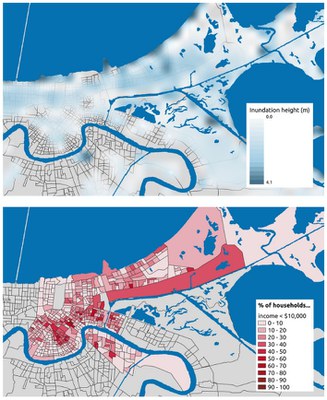WP 2 - Novel damage functions, impact channels and spatial heterogeneity
Work Package 2 is concerned with natural phenomena such as floods, storms, and droughts that can become hazards or even catastrophes if they happen to take place in the same locations where people or economic assets are and if they are strong enough to affect these.
We study the interplay between the strength of the natural phenomena and the distribution of  people and assets all over the world. We model how that interplay brings about the damages from catastrophic events that are regularly reported and archived in a summarized manner by agencies. Finally, we use that interplay to make future projections of damages accounting for climate change.
people and assets all over the world. We model how that interplay brings about the damages from catastrophic events that are regularly reported and archived in a summarized manner by agencies. Finally, we use that interplay to make future projections of damages accounting for climate change.
In order to do so, we identify indicators such as flood depth, wind speed, or crop yields that measure the potential hazardousness of a natural phenomenon. Furthermore, we collect socioeconomic data sources (such as population or assets) and historically reported damage data. We then try to explain the variations in reported damages by the collected data and indicators. The understanding of this relationship will enable us to make projections about how future climate scenarios might affect damages from extreme events.
With a similar approach, we study the effects of extreme events on people from different economic and social backgrounds. This improves our understanding of how climate change affects parts of the global population differently from each other.
Damages from extreme events are expected to be among the predominant effects of climate change on human life. Therefore, our understanding of the damages caused by extreme events will play an important role in improving the models of climate and economy (IAMs) developed in WP 4.
First results
Hazard types and economic damages
There are many types of natural hazards associated with climate change ranging from landslides and wildfires to tropical cyclones and droughts. Even the effects of tsunamis can be altered by climate change due to sea level rise and changes in ocean dynamics. However, in the context of the CHIPS project, we decided to focus our analysis on the following hazard types: river floods, crop failure from droughts, labor productivity, and tropical cyclones. Apart from modeling limitations and data availability, there are several conceptional reasons why we made this particular choice:
1. River floods and tropical cyclones are among the costliest categories of extreme weather events, causing USD 37.1 bn and USD 51.9 bn (2018 values) in direct annual damage within the last decade on average according to reinsurance company MunichRE.
2. While river floods affect almost all inhabited areas of the globe, they are highly relevant for the situation in Europe where they are among the most important natural hazards in terms of economic damage. Recent changes in European river flood risk can already be attributed to climate change impacts.
3. A systematic damage quantification that takes into account the different hazard types (winds, rain, storm surge) of tropical cyclones doesn't exist on a global level to date. The objectives of and partners involved in the CHIPS project provide an ideal motivation and framework for a first step in that direction.
4. On a regional level, crop failures from droughts are expected to increase significantly under climate change; the most severe increase in drought risk is expected for the Amazon, the Mediterranean, and South Africa. In CHIPS, distributional effects of droughts in Spain were identified as a case study for WP 3.
5. Losses of capital stocks and reduced labor productivity are the principal transmission channels through which climate extremes impact on socioeconomic development in the long-run and can be directly employed in Integrated Assessment Models of Climate and Economy (IAMs) in WP 4.
For more detailed information see the M2.1 report which can be found here.
